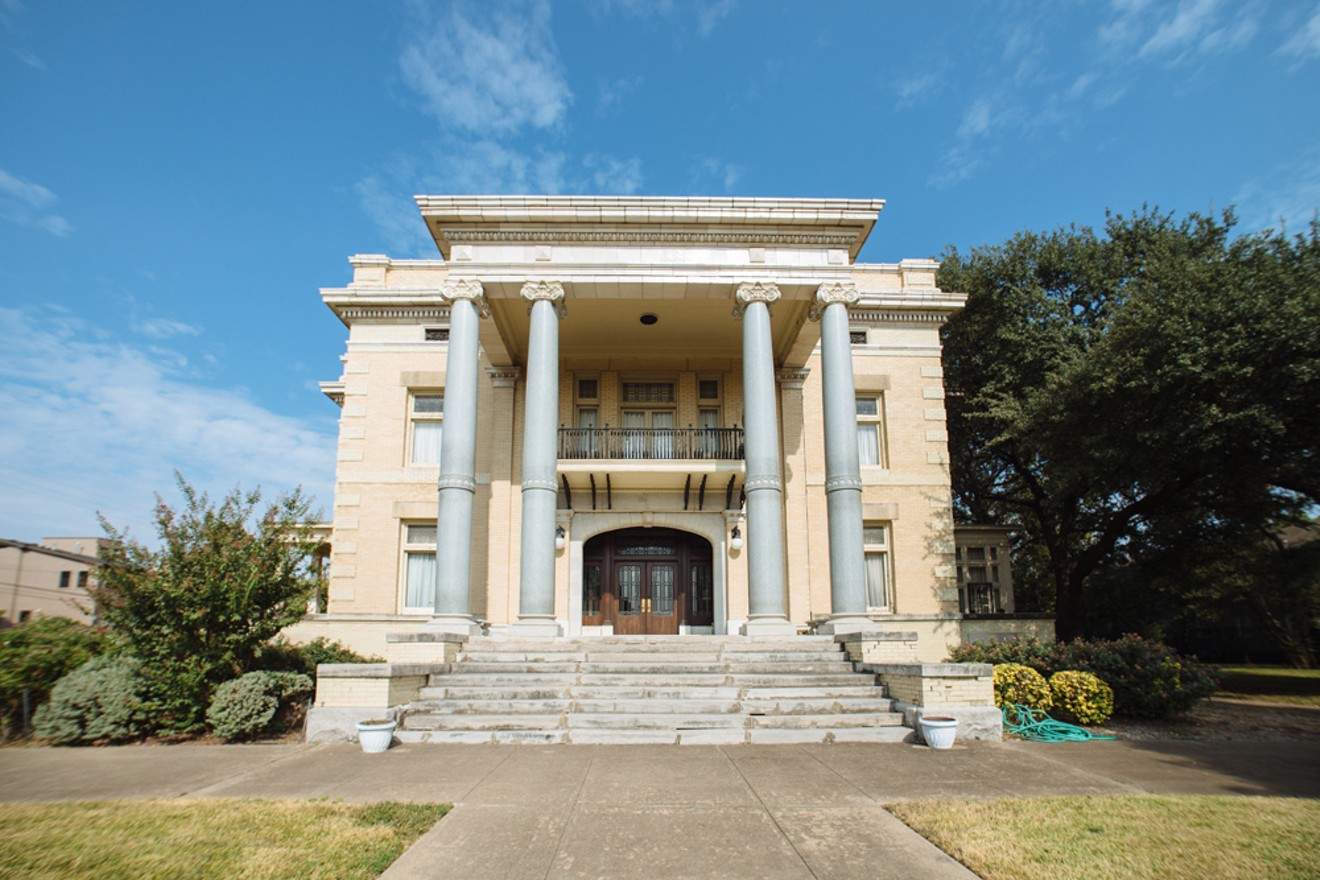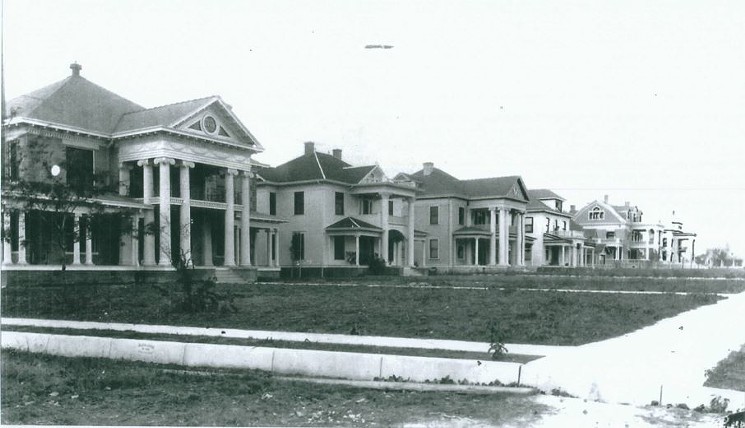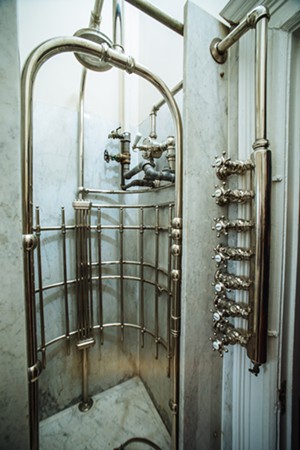You wouldn’t know it today, or even 50 years ago, but from the 1880s until the 1920s, Ross Avenue in Old East Dallas was known as the city’s Fifth Avenue. Opulent mansions lined the boulevard. Inhabitants shared a common denominator: They were rich. Oil tycoons and lumber czars hosted croquet matches in front yards and debutante balls in living rooms.
The Alexander Mansion, the 12,500-square-foot home at 4607 Ross Ave., is one of the last vestiges of that era and the focus of a dedicated band of preservationists who worry about its deteriorating condition. It needs a new foundation, a new roof and an exhaustive restoration of its exterior.
“I’m just terrified we’re going to start losing parts of the house because they’re not sealed off from water,” says architect Holly Hall, the grounds chair for the Dallas Woman’s Forum, the volunteer organization that has been headquartered at the mansion since 1930. The group purchased the property for $65,000 with assistance from George Bannerman Dealey. Had it not, the mansion would have become a funeral home and likely would have been razed decades ago.
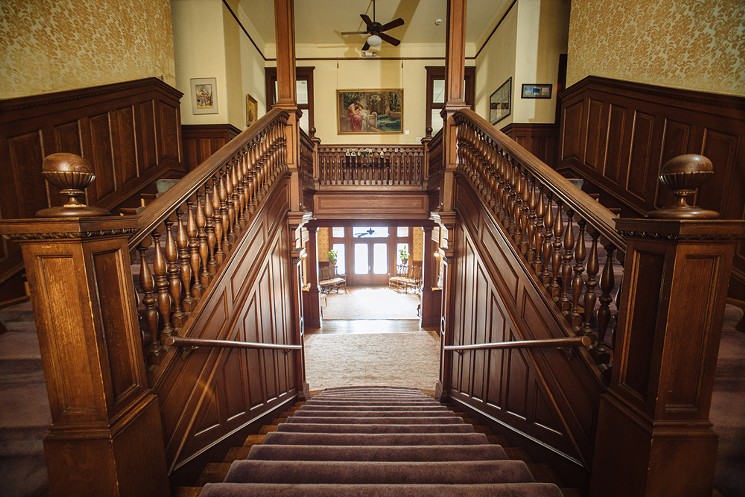
The Alexander Mansion is one of Dallas’ oldest residences and one of the few still remaining along Ross Avenue. Someone carved all the interior wood paneling by hand. Does this or does this not feel like the Titanic?
Kathy Tran
Alexander owned the Dallas Ice Factory and headed the Dallas Consolidated Electric Railway System, which electrified Dallas’ transportation system at the turn of the 20th century. Under his direction, Dallas evolved from buggies to streetcars, a feat that earned him a half-million dollars.
He also was arrested for murder. His 1899 murder trial was a media frenzy and generated vintage yellow journalism headlines in The Dallas Morning News like “A Day of Sensations!” Alexander stood accused of killing his former business partner Major I.G. Randle.
According to The Dallas Morning News, witnesses testified that Alexander told them he’d burned the Eakins house on Harwood Street in South Dallas as a favor for Randle and had yet to collect his bounty. Randle also owed him money from the sale of a sugar plantation in Louisiana they had co-owned.
“He had not been treated right and he wanted to get even,” one witness said. “‘If he don’t pay me, I will kill the ___ ____ ."
The Dallas Morning News ran subheads like “Courtroom crowded almost to suffocation again yesterday.” For months, it published sordid testimony transcripts rife with tales of corruption, bribery and covert midnight buggy rides to commit arson for insurance money.
The trial ended abruptly when the judge said to the jury: “Before [Alexander] could be legally convicted of this offense, the evidence of the state must show his guilt beyond a reasonable doubt. This … fails to do and therefore no conviction can be had in this case. You, gentlemen, are therefore instructed to return a verdict of not guilty."
Dallas Woman’s Forum past President Linda Turner says Alexander got acquitted of this charge and another for murder by paying off officials and jurors. "Only in the last few years have we been telling anybody about Mr. Alexander murdering people,” she adds.
In 1903, with the pesky murder charges behind him, Alexander hired architect C.D. Hill, of the firm Sanguinet and Staats, to build a mansion. He paid $125,000, sparing no expense. At a time when most people considered brick homes a futuristic pipe dream, Alexander built his with marble imported from Italy.
The imports included four marble columns, each two stories tall. When they arrived in Dallas, builders faced a logistical dilemma over how to transport them from the train station to the house. Mansion lore says it took a band of 20 horses to haul in each column on a custom-built carriage. People lined the streets and watched over their sack lunches.
People ran ads in The Dallas Morning News’ classified section asking to buy land, a house or anything near the Alexander Mansion. The address 4607 Ross appeared in the paper's society column on a regular basis.
One of the sprightlier affairs, probably, was an “informal dance” in 1910. Alexander’s son Charles was a student at the University of Texas and brought home 75 members of the school’s Phi Gamma Delta and Kappa Alpha Theta chapters to his mom and dad’s for an entire week. “A punch bowl was flowing on the sideboard in the large dining room,” reported the Morning News. The after-party was at the Majestic Theater.
In a 1968 letter to the Dallas Genealogical Society, C.H.'s oldest daughter, Leonora McAllister, wrote:
"Mother was very indulgent and anytime we could find a piano player we rolled up the rugs and danced. Throughout the first floor we had 150 people dancing. At the time we did not have cabarets or a place in the hotels to dance.
"We had to 'hire a hall' and to provide an orchestra, so such events were few. As a result, our big home remained the meeting place for friends.
"Always on new year's there was an open house. No special invitations — it was just known that our friends were to come — and more often than not the crowd stayed on to dance that evening. Many times the weather was so pleasant that the dancers moved out onto the 'front porch' and even the sidewalk leading to the house for their dancing."
But by the 1930s, Ross Avenue faced changes that would end such high-flying days.
“Ross Avenue peaked early and went downhill quickly,” says Mark Doty, Dallas’ chief planner and historic preservation officer.
'So many rules'
In the early 1930s, the stretch of road beginning at Ross and Greenville avenues, adjacent to what’s now Central Expressway, became a state highway. New industry drove homeowners to newer, now higher-tier neighborhoods like Swiss Avenue and Highland Park. This section of Ross hadn’t been zoned for residential housing.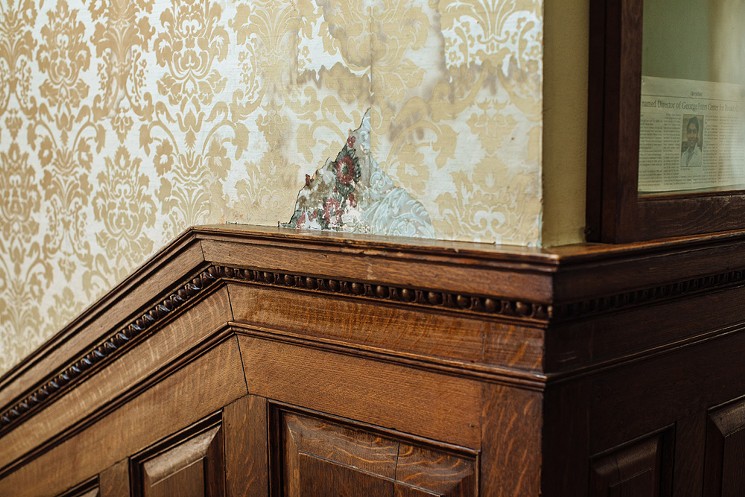
When it rains, water comes through the roof and down the walls. The house needs numerous repairs, but the roof is its first order of business. It’s expected to cost around $200,000.
Kathy Tran
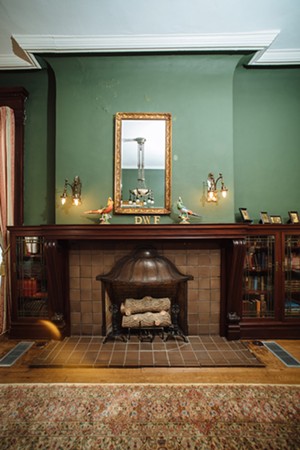
The mansion contains seven fireplaces, but this one is unusual. Lore claims that the Alexanders were traveling in Europe, they saw a large bell that they fancied. They purchased it, cut it in two and made the hood of the fireplace from half the bell.
Kathy Tran
Preservationists don't expect the city to provide funding to help.
“If you look at the city of Dallas, we don’t maintain our buildings, for God’s sake,” says Doty. “It’s millions of dollars, the backlog of funding for historic buildings. We don’t even take care of our new buildings.”
The Dallas Woman’s Forum started meeting with Doty about the historic designation process a few years ago. The organization received a plaque from the Texas State Historical Survey Committee in 1967, but it doesn't offer protection. Because the house needs major repairs, the women decided they should wait until they complete restorations to start the process to seek landmark designation from the city; the layers of city paperwork they’d have to clear to work on a landmark would be prohibitive timewise.
Guidelines for historic buildings are strict. For example, fixing old windows is hampered by a mandate to save as much of the original wood as possible. Theirs is rotted. Once a structure receives the designation, owners can’t even paint without permission from the city.
“There are so many rules concerning masonry, wood floors, what to do with old stonework," Hall says. "And so I told him [Doty] we were going to follow all those guidelines. Once he saw our intentions are to do it right, he relaxed. I think he was worried about the house getting destroyed.”
'Time capsule'
Underneath the sink in the kitchen, Hall found what she describes as a ratty, old wooden cabinet that looked like it had been in a 1950s house.“They took the cabinet out, and here was this mosaic floor! So somebody along the way put this one-by-one, 1960s ceramic tile atop of the mosaic floor,” she says. “There is a mosaic floor underneath the ugly 1960s tile in the kitchen. I’m just like, oh, what were they thinking?”
Hall keeps a bucket in the basement filled with the loose mosaic tiles she found. (A handwritten sign above it reads, “Do not sweep or vacuum this floor. Loose tiles!”) She hopes to hire someone to restore the flooring once she comes up with the $12,000.
Donations from companies like Siplast, which provided the materials for the mansion roof’s repair, are the best hope.
“There’s been no exterior work done to this place in many, many, many years,” says architect and roofing consultant Mike Cogburn of Arnold & Associates. “A lot of work needs to be done.”
The cost, though, is in the labor. Specialty contractors are needed to work on restoring such an old building, and that drives up prices. Cogburn says those involved are aiming to raise $1 million for an entire structural restoration, “and that might not be enough.”
He's not overly romantic, but he says Alexander Mansion is special.
"There are lots of properties that need to be torn down," he says. "But this one needs to be saved.”
“It’s the last remaining great house left with interiors that are intact. It’s a time capsule,” he says.
“We’re always concerned, in terms of preservation, with these neighborhoods that are becoming hot again. The Cedars, West Dallas," he says. "What are we losing, what could we potentially lose, when people try to turn them into the next Uptown?”

